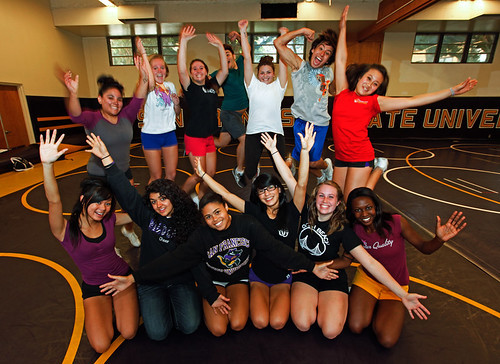
The most dangerous female sport is on the rise at SF State, and most students don’t even know it exists here.
However, this semester, the SF State cheerleaders are determined to get students’ attention by showing off their ability and enthusiasm to make their presence known.
“I didn’t even know we had a cheerleading team,” said Alicia Trobaugh, a senior and geology major at SF State who says she has only been to a few sporting events but has never even heard of the cheerleading squad.
This general student outlook is the focus of change for the SF State cheerleaders this semester. The squad has been on a steady incline for about two years since the addition of club adviser Larry Birello.
Several studies done in 2009 by the American Association of Cheerleading Coaches and Administrators and LiveScience concluded that cheerleading is the most dangerous–and possibly lethal–sport for women. Cheerleading is a high-risk injury sport, and the girls at SF State feel as though they get little recognition for the hard work they put in.
“Some people think (cheerleading) is dancing,” president and captain Danielle Guitard said. “We want to be seen as strong and powerful.”
Birello has been a key player in advocating for the increased level of competition the cheerleaders hope to reach in upcoming years. However, more immediately, he hopes to promote awareness within the University.
“We want to be at a more collegiate level,” Birello said.
Although he is not directly a coach, Birello is an active adviser with a focus on safety. Birello’s goals for the team this year includes sharp, exact moves and precision in their performances. He believes people don’t respect a team that looks sloppy and inconsistent.
Apart from an essential higher level of performance, the cheerleading squad has another factor to worry about: finances.
As a result of a federal court ruling in Connecticut last year, cheerleading is not recognized as a sport because of a disorganized and undeveloped system. On these bases, most collegiate cheerleading teams receive no financial support from universities.
Birello recognizes the limitations the team faces without financial help. He estimates that any given cheerleader at SF State spends about $500 per semester to be on the team.
Guitard said the team is trying to set up fundraisers and find sponsors to help with the team’s financial obligations.
“I’ve lost students who can’t do cheerleading and stop working,” Birello said.
Birello said he’s lost six people due to budget troubles.
“We want to be seen as supportive of our school and athletes,” Guitard said. She also wants her team to be recognized for the dangerous and hard work that they put in.







